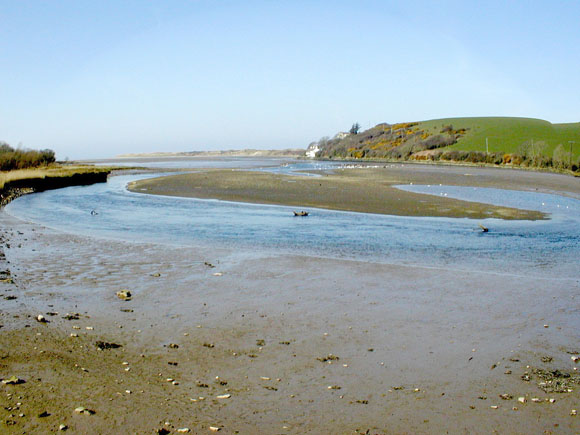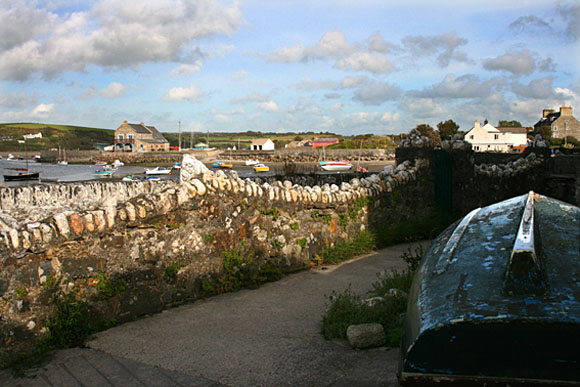Newport - From 'A Topographical Dictionary of Wales' (1849)
NEWPORT, a sea-port, market-town, and parish, in the union of Cardigan, hundred of Kemmes, county of Pembroke, South Wales, 19� miles (N. E. by N.) from Haverfordwest, and 242 (W. by N.) from London; containing 1751 inhabitants. The ancient British name of this place, Tr�vdraeth, signifying literally "the town on the sands," appears to have been derived from its situation on a sandy beach of considerable extent, which intervenes between it and the bay of Newport. The town is indebted for its origin and early importance to the descendants of Martin de Tours, the first lord of Kemmes, which territory he had wrested from the Welsh by conquest, and erected into a lordship marcher. William, son of Martin, built a castle at this place, which he made the head of his barony, and endowed with many privileges. He bestowed upon the inhabitants a charter of incorporation, vesting the government of the town in a mayor and burgesses, to whom he gave an extensive grant of lands, with liberty to hold a weekly market, and several valuable immunities; all which were confirmed, in 1192, by his son Nicholas, who granted common pasture, and water from the fosse, and whose charter declares that the burgesses "ought to have a bailiff and common council." The lordship was entirely independent of the palatinate of Pembroke: the lord held his courts in the castle of this place; all writs were issued in his own name exclusively, and neither in that of the Earl of Pembroke, nor even of the King of England. In 1215 the castle was taken by Llewelyn ab Iorwerth, but it soon afterwards reverted to its original proprietors, whose descendants continued to hold it, together with the lordship, in which they exercised jura regalia, till the time of Henry VIII., when all such jurisdictions were abolished.
Under the protection of its ancient lords the town increased in extent and wealth, and enjoyed many additional privileges, some of which were granted to the barony in the 34th year of the reign of Elizabeth. It had become extremely populous, and carried on an extensive woollen manufacture, about the commencement of the sixteenth century, when a pestilential disease occasioned such mortality among its inhabitants, that its market was transferred to Fishguard, the trade of the port ceased, and the town fell into decay. The market has however been reestablished, and some little addition to its trade has gradually taken place since that period; but the town has never recovered its former importance.
Newport stands on the high road from Cardigan to Fishguard, and is pleasantly situated at the mouth of the river Nevern, which falls into St. George's Channel at Newport bay, and on ground ascending gradually to the Carn Ingle mountain, which shelters it from the south-easterly and south-westerly winds, and rises to a considerable height beyond the town. It consists of small streets irregularly formed, and is neither lighted nor paved, but the inhabitants are naturally well supplied with excellent water. The houses, with some few exceptions, are indifferently built, but, from the intermixture of numerous trees with the buildings, the town, at a small distance, has a pleasingly rural appearance; and the surrounding scenery, in which its venerable church and the picturesque remains of its ancient castle form prominent and interesting features, renders the more remote view of it strikingly beautiful.
The trade principally carried on is the working of some extensive quarries of slate, with which the neighbouring coast abounds, and of which great quantities are shipped to various places, the vessels being enabled to approach close to the quarries, and to receive the slates from the overhanging cliffs. In the burning of lime, also, for the supply of the adjacent districts, a considerable portion of the population is employed. A vein of alum shale is said to lie within a short distance of the town, but it has never been worked. There is a salmon-fishery on the river Nevern, which in favourable seasons is carried on with advantage; and a herring-fishery also exists here, but the demand is so inconsiderable that it is not productive of much benefit to the persons engaged in it. The port is subject to the customhouse of Cardigan: the principal exports are corn and butter, and the produce of the quarries; the chief imports are coal, culm, and limestone. The harbour, which is small, has its entrance partially obstructed by a sand-bank; but it affords good shelter to the coasting-vessels occupied in the trade, and to the boats connected with the fisheries. A compact and well-protected bay, on the south and east, stretches out before the town, from which it derives its name of Newport bay. The market is on Friday; and fairs take place on June 27th and October 16th.
Newport retains the ancient form of government which it held under the charter granted by William, son of Martin de Tours, and afterwards confirmed by his son Nicholas. The control is vested in a mayor, bailiff, and an indefinite number of aldermen and burgesses. The mayor, who acts as a sort of head constable, is appointed by the lord of the borough from two burgesses presented by a jury; the bailiff, or pound-keeper, is chosen by the mayor; and the body of aldermen consists of those who have served the office of mayor. Courts leet and baron occur twice in the year; the petty-sessions for the hundred are held in the town on the first Friday in every month, and Newport is a polling-place in the election of a knight for the shire. The freemen, who are appointed by presentment of the jury, at one of the courts leet, are entitled to common and pasture upon the waste lands, which are about three miles in circumference. The boundaries of the borough are co-extensive with those of the parish, and are well ascertained, being duly perambulated at certain periods.
The living is a discharged rectory, rated in the king's books at �16, and endowed with �400 parliamentary grant; present net income, �216, with a glebe-house; patron, Thomas Lloyd, Esq., of Bronwydd, lord of the manor. The church, dedicated to St. Mary, is an ancient and venerable cruciform structure, partly in the early style of English architecture, with a square tower at the west end. The roofs of the nave, chancel, and transepts, all of carved oak, are supported on ranges of plain pointed arches, and in the chancel are two stone canopies plainly wrought; over the nave is a richly wrought open spire for a bell, and the windows exhibit tracery of considerable elegance. The building a short time since received an addition of 418 sittings, towards defraying the expense of which the Incorporated Society for the enlargement of churches and chapels contributed �200, in consideration of which grant 218 of the new sittings are free. On the west side of the porch are the ruins of a detached house, said to have been the record office of the town. There are places of worship for Baptists, Independents, and Calvinistic Methodists. A school on the National system is supported here on the foundation of the late Mrs. Bevan, for the gratuitous instruction of poor children; it is a permanent establishment, and the central school in which the teachers are prepared who superintend the several circulating branch institutions connected with the foundation. The school contains about 150 males and females; and the master has a salary of �40 per annum, together with a house and garden rent-free. This plan of "circulating" instruction was originally projected by the Rev. Griffith Jones, of Llandowror, in the county of Carmarthen, in the article on which parish an account of the charity is given. A British school is supported by subscription; and four Sunday schools are held, one of which is in connexion with the Established Church.
On an elevated knoll rising abruptly at the extremity of the principal street in the town, are the remains of the ancient castle, consisting principally of one of the circular bastions that defended the grand entrance, the other having of late years fallen down, and some portions of the dungeons, between which and the town was a subterraneous communication, discovered not many years ago. The bottom of this concealed way was flagged, and the sides and the roof were secured by smooth stones. The castle was surrounded by a moat, and though the ruins bespeak it to have been originally occupied as a seat of baronial magnificence rather than as a fortress, it was no doubt well adapted to both purposes, and in its general construction it appears to have combined strength with elegance. Newport bay, bounded by the headlands of Dinas and Ceibwr, opens beautifully in front, rendering the situation peculiarly delightful. Beyond the site of the castle rises the lofty rocky eminence of Carn Ingle, where St. Brynach, to whom many churches in Wales are dedicated, is said to have passed his life in religious seclusion, and to have conversed with angels, from which fabulous tradition the place has been termed also "Mons Angelorum." There are Druidical remains in the vicinity: about half a mile from Newport, in a field on the Fishguard road, and near a bridge, are some very curious antiquities of this kind, consisting of a small chamber formed of massive stones; and close to the town, in a field on the road leading to Berry Hill, about 200 yards from the Nevern river, is a very fine cromlech. On a hill connected with Carn Ingle is a large stone, named Morris' Grave. According to Speed there was anciently a house of Augustine friars at this place, but no particulars of its foundation or history have been preserved. |








